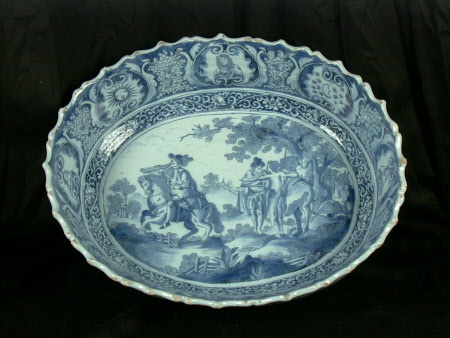Basin
workshop of Samuel Van Eenhoorn (1655 - 1686/7)
Category
Ceramics
Date
1678 - 1686
Materials
tin-glazed earthenware, in-glaze cobalt blue and manganese black
Measurements
417 mm (Width) x 125 mm (Depth); 485 mm (L)
Place of origin
Delft
Order this imageCollection
Dyrham, Gloucestershire
NT 452233
Summary
Basin, delftware, oval form with near vertical sides and indented rim, Samuel van Eenhoorn, De Grieksche A, Delft, Netherlands, 1867-1686; hand painted in blue, to the exterior hunting scenes, at the centre on the interior is a rural scene with, to the left, a man on horseback blowing a trumpet, to the right are two figures standing beside a horse, around the well are panels painted with bust portraits and alternating suns and moon with stars.
Full description
The collection of Dutch delftware at Dyrham is one of the best historical collections of this material in the world, rivalling those at Hampton Court and Chatsworth. Most collections of delftware at this time were assembled by courtiers such as the Duke of Devonshire or the Earl of Portland. William Blathwayt (1649-1717) wasn’t an aristocrat, he was a government administrator – an early civil servant. However, he was a brilliant networker with direct connections to the Palace. He began his career in the Hague as private secretary to the British Ambassador, where he learnt to speak Dutch. Blathwayt served under six monarchs during his long career, including King William III and Queen Mary II, who was herself an avid collector of delftware. Blathwayt’s ceramics reflect his ambition to recreate the fashionable court style of William and Mary in his own home, as well as expressing his loyalty to the crown. The collection of delftware at Dyrham includes rare and unique forms, including some that are likely to have a direct royal connection. Another important aspect is its documentary evidence. Many pieces are listed in inventories of Dyrham made in 1703 and 1710 – around the time the pieces were being acquired by Blathwayt and their early use at Dyrham. About a third of the original collection remains at the property. Samuel van Eenhoorn inherited the De Grieksche A (The Greek A) workshop from his father, Wouter van Eenhoorn. Samuel ran the workshop for about seven years before it was passed to his widow and then sold to Adriaen Kocx. De Grieksche A was one of the major producers of delftware in the Netherlands and the collection at Dyrham Park includes many pieces produced at the workshop. Delftware was a type of ceramic made with a white, opaque glaze made from tin, that could be decorated with coloured pigments. Most delftware is painted with cobalt blue, which provided a similar effect to Chinese porcelain. The source of the painted scene on the interior of the basin has not been identified. The subject has been interpreted as either historical or satirical, but it might also represent the parable of The Good Samaritan, which is a known subject on delftware.
Provenance
Indigenous collection purchased by Ministry of Works in 1956 and given to Dyrham Park in 1961.
Marks and inscriptions
Underside of base: SVE: / 34 (on-glaze blue)
Makers and roles
workshop of Samuel Van Eenhoorn (1655 - 1686/7), manufacturer De Grieksche A factory (fl.1658 - 1811), manufacturer
References
Archer 1975: Michael Archer. “Delft at Dyrham.” National Trust Year Book (1975-76), figure 1
